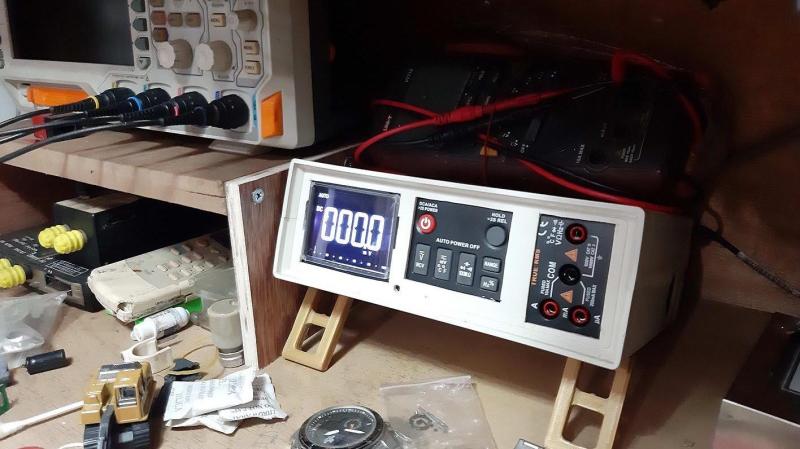A few years ago [Mechatrommer] got one of the low-cost Aneng Q1 multimeters and has converted it into a bench top meter. He first tried and failed to do an LCD modification and set it aside. It remained in a storage box until he needed another meter to repair his rubidium frequency standard. Finding that off-the-shelf bench multimeters were literally off-the-shelf — they were too deep for his bench — he decided to take matters into his own hands.

He dug out the dismantled an Aneng Q1 and undertook a more drastic modification than before, slicing the multimeter into three pieces and mounting each piece in a new enclosure. The power-draining back-lit display of the Q1, problematic in a battery-powered handheld meter, isn’t an issue in a bench top design. [Mechatrommer] replaced the battery pack with a mains powered supply. Next he reconnected all the signals which had been interrupted by the bandsaw, and now the meter lives again.
The resulting meter is pleasing enough (ignore the sideways input jacks) and looks like a typical piece of home-brew test gear. The enclosure has a lot of empty space, which he uses to stow test leads and sandwiches (we saw a similar storage compartment in [Dave Jones]’s recent teardown of a portable Fluke 37 multimeter). Kudos to [Mechatrommer] for coming up with this unusual conversion project.
We’ve written about the differences between these low-cost and more professional multimeters before if you want to learn more.
Thanks to [Adrian] for the tip.
















Not bad, and it’s battery powered too.
I would of just bought an old Keithly or something if it were me.
I’ve thought of this, but thought it not likely feasible.
Fifty years ago somebody suggested taking a VOM and mounting it in a metal box, so it could stand up. That could be done with a DMM, though the height might cause problems on a shelf. No mods to the meger just cut a suitable hole in the box, and hold it in place somehow (I can’t remember how the original suggestion went). Add some weight so the box doesn’t tip over.
Of cpurse, there are LCD panel meters, put one in a horizontal case, and add a range attenuator and other functions. You could then even add a parallel analog meter via an opamp buffer.
I bought my Fluke 37 at auction for (IIRC) $15. Nice!
Someone I knew had one and modified the probe with a button to active the Hold function.
Interesting, but couldn’t you accomplish the same thing with a wall wart power supply and a stable mount for a portable meter? The surgery risks destroying the meter for little pay off. Making a drop-in, stable stand that powers the meter would be more useful because you could still grab the meter and go when you need to. I’d be very surprised if there aren’t already commercial devices like that.
this hopefully has less tendency to walk off the bench than a standard fist-sized portable meter, but I could definitely see a case (lol) to be made for a weighted stand for a standard meter. the other thing this does is puts the geometry into a horizontal stack rather than vertical. sometimes that’s What You Want. and wrecking a $30 meter isn’t going to break the bank of a well-equipped workshop owner
“I could definitely see a case (lol) to be made for a weighted stand for a standard meter.”
I’ve done that for two identical models sitting side by side.
Right, tape it to a brick :-D
Plugging it in also leaves your ground isolation to some unknown device.
A reason for the bench-top multimeters to exist is that it is difficult to integrate high accuracy, resolution and speed in a small box. By crippling a handheld DMM and placing it into a bigger box you don’t get any of these benefits. So why’d someone do it is a mystery to me.
Why would someone do it? Some of us just can’t resist taking things apart and doing something different. It’s fun.
As Jan Steinman says, “too much time on our hands.”
I thought it was because benchtop meters looked cool. Radio Shack had one, I missed getting one when they were cleared out, but I assumed they were equivalent to their top end portable DMM, except different casing.
Talk about coincidence! For the past few weeks I’ve been thinking about doing this and pondering how to get what I want. Bench meters are way too expensive when I only need the functionality and accuracy of a $30 handheld unit, but the handhelds are awkward for bench use.
My problem is that I can’t stand auto-ranging meters, so I’ve been trying to figure out how best to make a bench meter out of a handheld that has an eleventy-seven-position rotary switch for selecting functions and ranges. I don’t look forward the the kludgy PCB butchering THAT job would require…
Buy a used Fluke 8010A for about $30. Manual ranging, better accuracy than you need, and it keeps it out of the landfill!
You’ve got way too much time on your hands… :-)